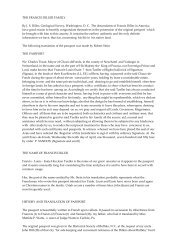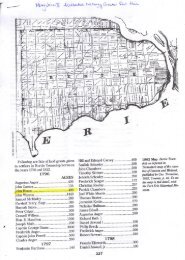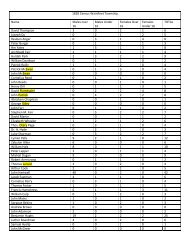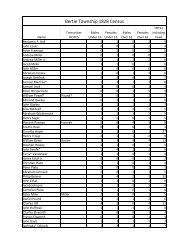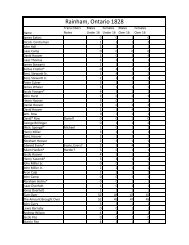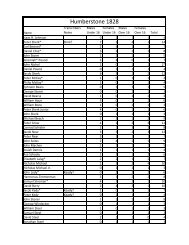Lutheran Trinity Church Stone Arabia, N. Y. - Crego-Jones Family ...
Lutheran Trinity Church Stone Arabia, N. Y. - Crego-Jones Family ...
Lutheran Trinity Church Stone Arabia, N. Y. - Crego-Jones Family ...
You also want an ePaper? Increase the reach of your titles
YUMPU automatically turns print PDFs into web optimized ePapers that Google loves.
6 LUTHERAN TEINITY CHURCH<br />
"The misery of these poor Palatines, I every day behold, has<br />
thrown me into such a fit of melancholy that I much fear a<br />
sickness. There has been a great famine among them, this<br />
past winter and does hold on them still, inasmuch that they<br />
now boil grass and the children eat the leaves of the trees.<br />
Such among them have most suffered with hunger as are advanced<br />
in years and are too weak to go out a laboring. I have<br />
seen old men and women cry that it should almost have moved<br />
a stone. I have given the bread out of my own mouth to many<br />
a one of these not being able to behold their extreme want."<br />
300 men went with Col. Nicholson on the expedition against<br />
the French (their old enemies) in Canada in 1711. They were<br />
promised pay and their arms. They received neither Many rebelled.<br />
Finally in March, 1712, 50 families moved to Schoharie,<br />
on land promised them by the Indians. Some undoubtedly came<br />
direct to <strong>Stone</strong> <strong>Arabia</strong>, others followed into Schoharie until in<br />
1718 there were 170 families and 680 souls there, not including<br />
widows and orphans. In that year, there were in all 394 families<br />
or 1601 souls, Palatines, in the province of New York. In eight<br />
years the 2300 who had survived the voyage had decreased by 700,<br />
which speftks eloquently of their sufferings.<br />
In November, 1720 John Wilhelm Scheff, one of the Palatine<br />
Commissioners sent to England to secure redress, stated that there<br />
were about 500 families and about 3,000 souls in the province of<br />
New York plus the Schoharie contingent. If the estimate of<br />
Haeger and Kocherthal was correct in 1718 and if Scheff is correct<br />
two years later, the period of 1718-20 must have witnessed<br />
another influx of Palatines into New York.<br />
But in Schoharie, they were not to be entirely happy. They<br />
found that the land had been given by the authorities to others.<br />
These others endeavored to secure payment for the land in one<br />
way or another. Many families refused.<br />
Gov. Burnet on Nov. 21, 1722 reported about 60 families in<br />
Schoharie who were desirous of separating themselves from<br />
Schoharie and settling in the Mohawk Valley. He granted their<br />
wish, and in all probability these families became in large part<br />
at least the <strong>Stone</strong> <strong>Arabia</strong> and Burnetsfield (German Flatts) Patentees.<br />
STONE ARABIA, NEW YORK. 7<br />
The Name<br />
ERHAPS, something should be said at the very first about<br />
the name <strong>Stone</strong> <strong>Arabia</strong>. The name first appears in Dutch<br />
Colonial history fifty years before the settlers of present<br />
<strong>Stone</strong> Ai-ibia received their grant of land from the King in 1722.<br />
Under a patent dated 19 October 1669, Robert Sanders and<br />
Harmen Vedder bought of the Mohican Indians land called by<br />
the Indians "Taescameasick", lying on the east side of the North<br />
River and stretching. along the river "from the Second to the<br />
Third Spring which runs over the west side of the river straight<br />
into the woods up to the High Falls.'* 21 August 1670 Hafmen<br />
Vedder conveyed his interest to Robert Sanders. Reference to<br />
this land is made in a lease given by Robert Sanders to Hendrick<br />
M. Vrooman, 3 May 1670, wherein it is described as "lying over<br />
against the long island."<br />
In 1680, Robert Sanders sells his farm which lies on the east<br />
side of Hudson's river obliquely over against the farm of Anthony<br />
van Shayk, commonly called "Steen <strong>Arabia</strong>."<br />
These references determine a "Steen <strong>Arabia</strong>" on the Hudson.<br />
In the colonial manuscripts Captain Schuyler in his report of<br />
his journey to Canada, says, "The 27 of August we went from<br />
Albany and came to Stony <strong>Arabia</strong> 8 miles up the river where we<br />
lodged that night."<br />
The editor of the manuscripts, O'Callaghan, in a footnote says<br />
this Stony <strong>Arabia</strong> was the site of modern Lansingburg, or North<br />
Troy.<br />
And it is probable that the name was transferred to its new<br />
location in the Mohawk Valley in this wise: Robert Sanders was<br />
an Indian interpreter for Governor Fletcher in the last decade<br />
of the 17th century. He was much in favor with the Indians. He<br />
was a merchant in Albany. He probably acted as interpreter for<br />
the <strong>Stone</strong> <strong>Arabia</strong> patentees in the purchase of Indian land. They<br />
probably traded with him. And in some way, the name of his<br />
Hudson Valley farm came to be the name of the <strong>Stone</strong> <strong>Arabia</strong><br />
Patent. This supposition is strengthened by the fact that in 1765,<br />
a son of one of the patentees makes a Robert Sanders, a son of<br />
the Robert mentioned above, an executor of his will. This Robert<br />
was a merchant in Albany and Conrad Weiser calls him the mayor<br />
of Albany in 1753-4.



